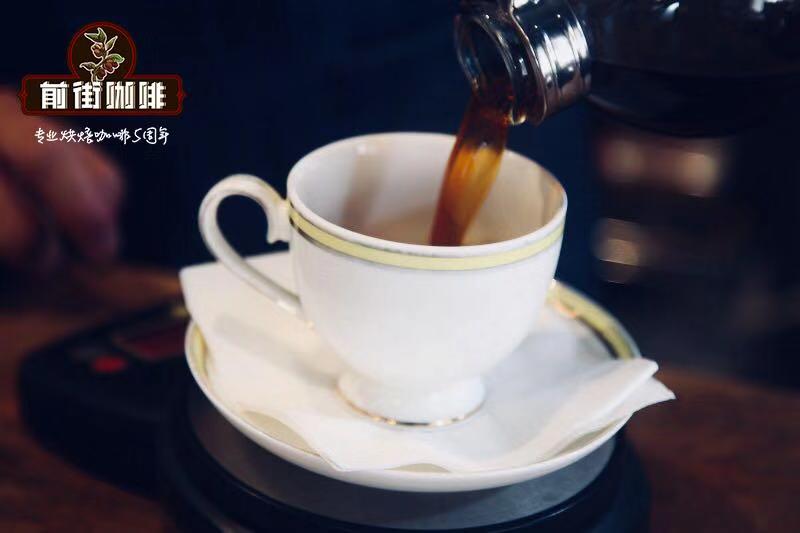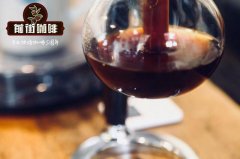Do you know the types and distribution of coffee beans? what are the kinds of sour coffee beans?

Professional coffee knowledge exchange more coffee bean information please follow the coffee workshop (Wechat official account cafe_style)
Morphine is native to Africa and has many varieties. Each variety is related to specific climatic conditions and a certain altitude. The wild coffee tree is an evergreen shrub, 3 to 3.5 meters high, with small white flowers on its branches and a jasmine fragrance. The fruit is 1.5 to 1.8 cm long and red, with two seeds arranged adjacent to each other, each covered with endocarp and epicarp.
There are about 60 species of coffee plants in the world, of which only 25 species are cultivated to make coffee, of which only 4 species are used as commercial coffee: large fruit coffee (Coffea liberica), medium fruit coffee (Coffea canephora), small fruit coffee (Coffea arabica) and high yield coffee (Coffea dewevrei).
Small fruit coffee: recognized as the best variety, it can only grow in hilly areas with fertile land and good drainage above 600 meters above sea level, so it was originally grown only in the highlands of Cameroon and Guinea, and later introduced to Latin America and Asia.
Medium fruit coffee: its origin is in Central Africa. One of the varieties is sturdy coffee (Coffea robusta), which has higher disease tolerance and fruit yield. It can be cultivated in hot and humid areas where small fruit coffee can not survive, and is mainly used to produce instant coffee.
Big fruit coffee: the country of origin is Liberia, widely distributed, very patient, but poor quality.
Brazil
Brazil is the world's largest major coffee producer and exporter, accounting for 1. 3% of the world's total production. One of the most famous is Sandos Coffee, which is mellow in taste, moderately sour and bitter, and easy to taste. It can be boiled directly or mixed with other kinds of coffee beans to form a comprehensive coffee. Other kinds of Brazilian coffee, such as Rio and Parana, can be produced in large quantities because they do not require too much care. Although the taste is rough, it is a kind of coffee with good quality and low price.
Colombia
The coffee output of Colombia is second only to Brazil, and the more famous producing areas are Medellin, Manizares, Bogota, Armenia and so on. The coffee beans cultivated are all Arabica varieties with a rich and thick flavor. Among them, Supremo coffee beans are of good quality, high aroma and mellow, coffee particles are large, sour, bitter, sweet and strong, such as brewed wine. Roasted coffee beans are bigger and more beautiful.
Hawaii
The most traditional and famous coffee in Hawaii is Kona, which tastes sweet and sour with the sour taste of a pleasant wine. It is so named because it is produced on the southwest coast of Hawaii. However, because the output here is not high, the cost is surprisingly high, so the price is not low, and it is not easy to buy.
Central America
Mexico
Mexico is a major coffee producer in Central America. The coffee here is comfortable and fragrant. The best Mexican coffees are Coatepec, Huatusco and Orizaba, among which Cottpe is considered to be one of the best in the world. The coffee cultivation belt of this country is similar to Guatemala in the south in both geographical and climatic conditions, so it is included in the scope of "China and the United States". The main producing areas are distributed in Goa DiBuick, Oaxaca and other states, especially the water-washed coffee beans produced in the highlands, which have excellent aroma and sour taste.
Costa Rica
The coffee beans produced at the high latitudes of Costa Rica (Tarasu region) are stronger and more mellow, but extremely sour and famous in the world. The coffee beans here are of high quality after careful treatment. The place of production can be roughly divided into three areas: the Pacific coast, the Atlantic coast and the middle zone, and each is graded according to its elevation. All the coffee beans are quite large, especially those from the highlands along the Pacific coast, which are sour and fragrant. There is nothing special about the sour rather than mellow coffee beans of the lowlands along the Atlantic coast.
Guatemala
The central region of Guatemala is home to world-famous coffee with excellent flavor. Most of the coffee beans here have charcoal flavor and cocoa flavor, but their acidity is slightly stronger. The first producing area is located in San M á rquez, which is close to the mountains of Mexico. The second place of origin is Caesar Denango in the south. Other brothers and gangs and Antigua are also very famous. Slightly sour, mellow and smooth, it is the best material for mixed coffee. It is divided into 7 grades according to the elevation mark, and the ones produced in the highlands are more fragrant and mellow.
El Salvador
El Salvador ranks alongside Mexico and Guatemala as producers of the Asa-Maird Group and competes with other countries for the top one or two places in Central America. Large well-proportioned coffee beans from the highlands have a strong flavor and a mild taste. It is also divided into three grades according to elevation: SHB (Strictly High Grown) = highland, HEC (High Grown Central) = mid-highland, and CS (Central Standard) = lowland.
Honduras
Washed coffee beans in the mountains of Honduras are well received, while coffee beans produced in the lowlands are of lower quality. Well-known producing areas are Santa Barra, Gracias, Komayagya in the east, and Chortika near Nicaragua. Coffee beans range in size from medium to large and are characterized by a mild taste. The hilly area is better, the quality produced in the lowland is slightly worse, and it is also divided into three grades according to the elevation.
West Indies
Jamaica
Jamaica is a republic of large and small islands located in the Caribbean. Most coffee grows above 1525 meters above sea level and is cultivated on the slopes of the mountains on Hengduan Island. The producing areas can be divided into three areas: BM (Blue Mountains), HM (Alpine) and PW (Plame washed coffee beans), which are also the brand names of coffee. The ranking of quality and price is 1, 2, 3, and the ranking of production is 3, 2, 1. Among them, "Blue Mountain" is the most expensive coffee in the world because of its average flavor, aroma, strong and sour taste.
Cuba
Cuba is famous for producing sugar, tobacco and coffee. Coffee was introduced from Haiti by the French in the mid-18th century. Coffee beans are characterized by medium-large grains and bright green. The classification of grades is divided into ETL (super grade), TL (middle pole) and AL (ordinary) according to the size of coffee beans. Mount Krister is Cuba's proudest high-quality, large-shaped high-end coffee bean. The best coffee in Cuba is Tujino.
Africa
Kenya
Kenya is a coffee-producing kingdom, famous for its strong aroma and moderate acidity. Grow high-quality Arabica coffee beans, coffee beans almost absorb the essence of coffee cherries, with a slightly sour, full-bodied aroma, the size of beans for medium and large grains. The grade is divided into seven grades according to the size of the coffee beans and six grades according to the taste.
Ethiopia (Ethiopia)
The hometown of Arabica coffee, coffee grows at high latitudes and needs careful manual care. Here is the famous Ethiopian mocha, which is similar to wine in acidity, fragrance and high yield. In addition, the Eastern Highland Hara is also famous for its coffee. The beans are small and fragrant, and the special names of "Hara Mocha" and "Longgubeli" have a unique flavor, usually only known as "mocha". The mixed proportion of defective beans in its specification is divided into G1~G8 (G, Geade). Recently, the most eye-catching one is the high-quality "washing Ethiopia".
Tanzania
Tanzanian coffee is rich and elegant, similar to Chinese and American coffee, and less acidic than Kenyan coffee.
Cameroon and Ivory Coast
Cameroon and C ô te d'Ivoire produce a strong, bitter robusta coffee.
Asia
India
Indian coffee is slightly sour, a light coffee with a slightly alcoholic flavor.
Indonesia
The Superior Mantenin of Sumatra has a unique fragrant taste, slight acidity and good quality. In addition, Arabica coffee produced in Java is the favorite of Europeans. It is sweet in bitterness and sour in it for a long time. The main producing areas are Sumatra, Java, Sulawesi, Flores Island. 90% of them are Robbosa species, which can be rated as the first in the world in quality. Sumatra is best known for its rich, palatable and most advanced "Mantenin". However, importers have repeatedly criticized them for their poor quality and difficulties in processing and preservation. In addition, "Jiayu Mountain" is also produced in the north of the island, while Java Arabica has a good sour taste, especially loved by the Dutch. What Sulawesi Island produces is a large grain of "Kalosi", represented by "Delaga" produced in Traga (elevation 1200 meters) in the southwestern mountainous region.
Yemen
Yemeni mocha coffee was once all the rage, blowing a whirlwind of mocha around the world. However, due to political unrest and unplanned planting, the production of Mocha was very unstable. In spite of this, its alcoholic flavor and full-bodied characteristics are still the after-dinner coffee favored by many consumers. Mocha also plays an important role in matching other coffee beans or mixed coffee beans, and together with coffee from Brazil and Colombia, it is the three swordsmen who are chosen as blended coffee.
China
China's coffee production is mainly in Yunnan, accounting for 80% of the national output, Hainan is the second, and a small amount is also grown in Guangdong, Guangxi, Fujian, Sichuan and Taiwan. The western and southern parts of Yunnan Province are located between 15 °N and the Tropic of Cancer, most of which are 1000-2000 meters above sea level. The topography is dominated by mountains and slopes, with large undulation, fertile soil, sufficient sunshine, rich rainfall and large temperature difference between day and night. These unique natural conditions form the particularity of Yunnan small-grain coffee-strong but not bitter, fragrant but not strong, slightly fruity. As early as the 1950s, Yunnan small seed coffee was very popular in the international coffee market and was rated as the top grade of coffee.
Yunnan coffee was planted on a large scale in the mid-1950s, with a planting scale of 4000 hectares at one time. By the end of 1997, the planting area of coffee in the province had reached 7800 hectares. At present, the planting area of coffee in the province accounts for 70% of the country, and the output accounts for 83% of the country. Yunnan coffee has established its dominant position in China in terms of planting area and coffee bean production. The suitable planting areas of coffee in Yunnan are distributed in Simao, Banna, Wenshan, Baoshan and Dehong in the south and southwest of Yunnan.
END
Important Notice :
前街咖啡 FrontStreet Coffee has moved to new addredd:
FrontStreet Coffee Address: 315,Donghua East Road,GuangZhou
Tel:020 38364473
- Prev

Do you know what the two major coffee bean varieties are? what are the famous coffee bean varieties?
Professional coffee knowledge exchange more coffee bean information Please pay attention to the coffee workshop (Wechat official account cafe_style) Arabica flavor and aroma of good quality, often used to make boutique coffee, while robusta because it is easy to grow, has the advantage of low price, mainly used for hybridization or made as the main raw material of instant coffee. If the variety of coffee is divided according to biology, it can be divided into
- Next

Which variety of coffee beans is the least bitter? do you know what kind of coffee is not bitter?
Professional coffee knowledge exchange more coffee bean information please pay attention to the coffee workshop (Wechat official account cafe_style) coffee roasting process of the use of high temperature in the coffee bean starch caramelization, which brings sweetness and mellow feeling. Whether it is shallow baking, medium baking, deep baking, etc., the process of caramelization is inevitable, but the difference of heating degree and time leads to sweetness.
Related
- Beginners will see the "Coffee pull flower" guide!
- What is the difference between ice blog purified milk and ordinary milk coffee?
- Why is the Philippines the largest producer of crops in Liberia?
- For coffee extraction, should the fine powder be retained?
- How does extracted espresso fill pressed powder? How much strength does it take to press the powder?
- How to make jasmine cold extract coffee? Is the jasmine + latte good?
- Will this little toy really make the coffee taste better? How does Lily Drip affect coffee extraction?
- Will the action of slapping the filter cup also affect coffee extraction?
- What's the difference between powder-to-water ratio and powder-to-liquid ratio?
- What is the Ethiopian local species? What does it have to do with Heirloom native species?

